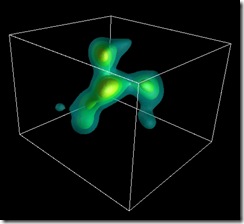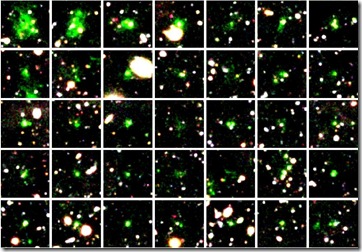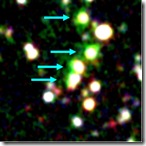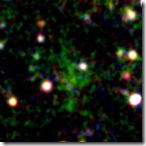(Image from http://www.subarutelescope.org/)
I've been home sick the last few days, so it gave me ample time to catch up on my saved History Channel and Nova episodes. While watching "The Universe" series on the History Channel highlighting the largest things in the universe I was introduced to the Lyman-Alpha Blob.
My first question is who comes up with the names for these things? Blob is the best we could do?!? The Lyman Alpha part refers to the filter, which filters the Lyman-Alpha emission line of hydrogen and allows us to see these amazing formations.
(Image from http://www.subarutelescope.org/ the LABs are green. Each square is 620 thousand light years across)
The Lyman-Alpha Blob or LAB is a concentration of gas. On the show it was compared to a giant bubble except instead of gaining its shape from gravity and air it moves and grows based on amassed energy and heat. The gas inside is moving at an estimated 300 miles per second. They are also immense! Some are more than 200 million light years across! Compare that to the our GALAXY, The Milky Way, which is only 100,000 light years in diameter. (That's 3,000 times larger for those keeping score) They aren't just big, they are also quite beautiful ameba-esque formations, constantly shifting and growing.
(Image from http://www.subarutelescope.org/)
LABs are relatively recent discoveries having been first seen in 2000 using the Subaru Telescope of the National Astronomical Observatory of Japan. Of course these LABs are so far away that we're really seeing what many of them looked like 12 million years ago. Scientist predict that the big bang was about 13.7 billion years ago, so 12 million is only a blip on the universal timeline.
Researchers believe these blobs are the precursors to the formation of large galaxies. So the blob is only a stage in a galaxies development. The blobs are regions where gas is collapsing under its own gravity in turn forming a galaxy. Some LABs have several galaxies already in their composition. With this discovery scientists hope to learn more about the cycle of a galaxy.
If this doesn't boggle your mind about just how large the universe really is then perhaps you should read up on the search for dark matter. There are so many amazing things out there in the universe!
I've done a fairly poor job of explaining these fascinating formations, so watch the video from the History Channel below to hear the experts give it a try! (Or go to http://www.history.com/video.do?name=The_Universe and watch The Universe: The Biggest Things in Space: Part II)







1 comment:
I'm not sure how many shows I would have to watch to figure what all of this means. MKL
Post a Comment